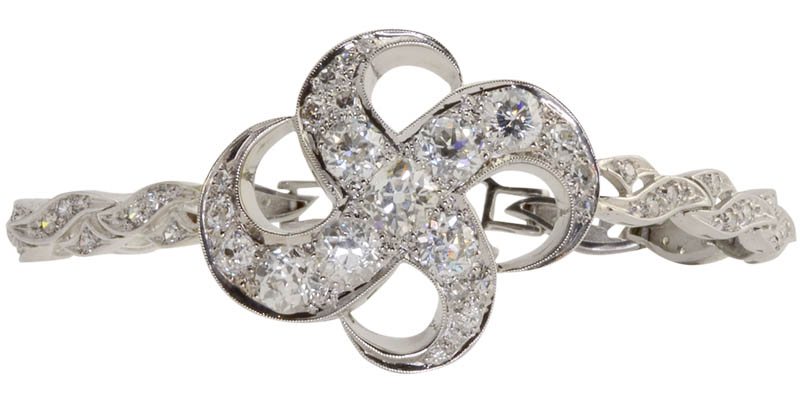The Art Nouveau era is a short but important period from 1890-1915. This design movement was in response to both the mass-produced jewelry of the Industrial Revolution and the ostentatious display of wealth that characterized much of the jewelry of the early 19th century and the Victorian age. Prior to the emergence of the Art Nouveau style, jewelry designs emphasized precious gemstones in settings that called attention to their fire, size, and color.
During the Victorian era, jewelry designs became heavier and darker, reflecting the Industrial Age and the prolonged mourning of Queen Victoria, whose name is the basis for the period. Artisans would use dark materials like onyx and jet to reflect the emergence of coal as the power source of the time and the somber mood of mourning that characterized the latter part of the Victorian era, at least in Britain.
In contrast, Art Nouveau jewelry history shows that the movement was more about the overall design of a piece than it was about the materials used or how precious metals and gems could be employed to impress viewers. Art Nouveau pieces incorporated glass and natural elements like bone and horn.
The Art Nouveau jewelry style tended to emphasize form over color, often using more muted earth tones of green, orange, tan, and brown. Two distinct enamel styles also emerged during the period: Plique-á-Jour (“let the daylight in”) and Guilloche.
Plique-á-Jour was distinguished by how artisans applied the enamel between metal borders but with no metal backing. The result was semi-transparent, with a stained-glass window effect. Guilloche involved etching an intricate design onto a metal piece and then meticulously painting in negative areas of the design with enamel.
Art Nouveau jewelry characteristics included botanical designs filled with curved forms and renderings of the female form, emphasizing curves and flowing hair. There could also be insects like dragonflies and butterflies, animals, or fantasy figures like mermaids and woodland fairies.
Art Nouveau jewelry was completely innovative and original. Its history demonstrates an impulse toward deliberately blurring the lines between so-called “fine” art and decorative art, architecture, and product design. The elements of the Art Nouveau jewelry style appeared not just in jewelry but also in painting, sculpture, and decorative arts like stained glass, furniture, and the architectural design elements of gates and fences.
The romance of jewelry was apparent during this movement, as it broke away from the heavy and darker designs of the Victorian period before. The curving forms, botanical design elements, and muted colors evoked a more natural world, in contrast to the rapid and heavy industrialization of the era.

